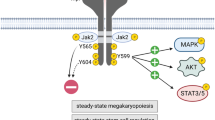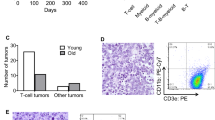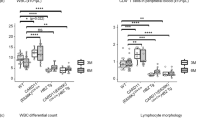Abstract
Myeloproliferative disorders (MPDs), lymphoproliferative disorders (LPDs), acute T-lymphocytic or myeloid leukemia and T-lymphocytic lymphoma were developed in inducible Pten (phosphatase and tensin homolog, deleted on chromosome ten)-knockout mice (Pten−/−). The appearance of these multiple diseases in one animal model provides an opportunity to study the pathogenesis of multiple diseases simultaneously. To study whether Myc function is required for the development of these hematopoietic disorders in Pten−/− mice, we generated inducible Pten/Myc double-knockout mice (Pten−/−/Myc−/−). By comparing the hematopoietic phenotypes of these double-knockout mice with those of Pten−/− mice, we found that both sets of animals developed MPDs and LPDs. However, none of the compound-mutant mice developed acute leukemia or lymphoma. Interestingly, in contrast to the MPDs that developed in Pten−/− mice, which are dominated by granulocytes, megakaryocytes predominate in the MPDs of Pten−/−/Myc−/− mice. Our study suggests that the deregulation of phosphoinositide 3-kinase/Akt signaling in Pten−/− hematopoietic cells protects these cells from apoptotic cell death, resulting in chronic proliferative disorders. However, owing to the differential requirement for Myc in granulocyte as compared to megakaryocyte proliferation, Myc deletion converts Pten−/− MPDs from granulocyte- to megakaryocyte-dominated conditions. Myc is absolutely required for the development of acute hematopoietic malignancies.
This is a preview of subscription content, access via your institution
Access options
Subscribe to this journal
Receive 12 print issues and online access
$259.00 per year
only $21.58 per issue
Buy this article
- Purchase on Springer Link
- Instant access to full article PDF
Prices may be subject to local taxes which are calculated during checkout







Similar content being viewed by others
References
Meyer N, Penn LZ . Reflecting on 25 years with MYC. Nat Rev Cancer 2008; 8: 976–990.
Eilers M, Eisenman RN . Myc's broad reach. Genes Dev 2008; 22: 2755–2766.
Hoffman B, Amanullah A, Shafarenko M, Liebermann DA . The proto-oncogene c-myc in hematopoietic development and leukemogenesis. Oncogene 2002; 21: 3414–3421.
Weng AP, Millholland JM, Yashiro-Ohtani Y, Arcangeli ML, Lau A, Wai C et al. c-Myc is an important direct target of Notch1 in T-cell acute lymphoblastic leukemia/lymphoma. Genes Dev 2006; 20: 2096–2109.
Fang ZH, Dong CL, Chen Z, Zhou B, Liu N, Lan HF et al. Transcriptional regulation of survivin by c-Myc in BCR/ABL-transformed cells: implications in antileukemic strategy. J Cell Mol Med 2009; 13: 2039–2052.
Schreiner S, Birke M, Garcia-Cuellar MP, Zilles O, Greil J, Slany RK . MLL-ENL causes a reversible and myc-dependent block of myelomonocytic cell differentiation. Cancer Res 2001; 61: 6480–6486.
Vita M, Henriksson M . The Myc oncoprotein as a therapeutic target for human cancer. Semin Cancer Biol 2006; 16: 318–330.
Smith DP, Bath ML, Harris AW, Cory S . T-cell lymphomas mask slower developing B-lymphoid and myeloid tumours in transgenic mice with broad haemopoietic expression of MYC. Oncogene 2005; 24: 3544–3553.
Harris AW, Pinkert CA, Crawford M, Langdon WY, Brinster RL, Adams JM . The E mu-myc transgenic mouse. A model for high-incidence spontaneous lymphoma and leukemia of early B cells. J Exp Med 1988; 167: 353–371.
Luo H, Li Q, O’Neal J, Kreisel F, Le Beau MM, Tomasson MH . c-Myc rapidly induces acute myeloid leukemia in mice without evidence of lymphoma-associated antiapoptotic mutations. Blood 2005; 106: 2452–2461.
Skoda RC, Tsai SF, Orkin SH, Leder P . Expression of c-MYC under the control of GATA-1 regulatory sequences causes erythroleukemia in transgenic mice. J Exp Med 1995; 181: 1603–1613.
Laurenti E, Varnum-Finney B, Wilson A, Ferrero I, Blanco-Bose WE, Ehninger A et al. Hematopoietic stem cell function and survival depend on c-Myc and N-Myc activity. Cell Stem Cell 2008; 3: 611–624.
Steelman LS, Abrams SL, Whelan J, Bertrand FE, Ludwig DE, Basecke J et al. Contributions of the Raf/MEK/ERK, PI3K/PTEN/Akt/mTOR and Jak/STAT pathways to leukemia. Leukemia 2008; 22: 686–707.
Kharas MG, Okabe R, Ganis JJ, Gozo M, Khandan T, Paktinat M et al. Constitutively active AKT depletes hematopoietic stem cells and induces leukemia in mice. Blood 2010; 115: 1406–1415.
McCubrey JA, Steelman LS, Abrams SL, Bertrand FE, Ludwig DE, Basecke J et al. Targeting survival cascades induced by activation of Ras/Raf/MEK/ERK, PI3K/PTEN/Akt/mTOR and Jak/STAT pathways for effective leukemia therapy. Leukemia 2008; 22: 708–722.
Gustafson WC, Weiss WA . Myc proteins as therapeutic targets. Oncogene 2010; 29: 1249–1259.
Bonnet M, Loosveld M, Montpellier B, Navarro JM, Quilichini B, Picard C et al. Posttranscriptional deregulation of MYC via PTEN constitutes a major alternative pathway of MYC activation in T-cell acute lymphoblastic leukemia. Blood 2011; 117: 6650–6659.
Gutierrez A, Sanda T, Grebliunaite R, Carracedo A, Salmena L, Ahn Y et al. High frequency of PTEN, PI3K, and AKT abnormalities in T-cell acute lymphoblastic leukemia. Blood 2009; 114: 647–650.
Cheong JW, Eom JI, Maeng HY, Lee ST, Hahn JS, Ko YW et al. Phosphatase and tensin homologue phosphorylation in the C-terminal regulatory domain is frequently observed in acute myeloid leukaemia and associated with poor clinical outcome. Br J Haematol 2003; 122: 454–456.
Silva A, Yunes JA, Cardoso BA, Martins LR, Jotta PY, Abecasis M et al. PTEN posttranslational inactivation and hyperactivation of the PI3K/Akt pathway sustain primary T cell leukemia viability. J Clin Invest 2008; 118: 3762–3774.
Maser RS, Choudhury B, Campbell PJ, Feng B, Wong KK, Protopopov A et al. Chromosomally unstable mouse tumours have genomic alterations similar to diverse human cancers. Nature 2007; 447: 966–971.
Shehata M, Schnabl S, Demirtas D, Hilgarth M, Hubmann R, Ponath E et al. Reconstitution of PTEN activity by CK2 inhibitors and interference with the PI3-K/Akt cascade counteract the antiapoptotic effect of human stromal cells in chronic lymphocytic leukemia. Blood 2010; 116: 2513–2521.
Larson Gedman A, Chen Q, Kugel Desmoulin S, Ge Y, LaFiura K, Haska CL et al. The impact of NOTCH1, FBW7 and PTEN mutations on prognosis and downstream signaling in pediatric T-cell acute lymphoblastic leukemia: a report from the Children's Oncology Group. Leukemia 2009; 23: 1417–1425.
Barata JT . The impact of PTEN regulation by CK2 on PI3K-dependent signaling and leukemia cell survival. Adv Enzyme Regul 2011; 51: 37–49.
Yoshimi A, Goyama S, Watanabe-Okochi N, Yoshiki Y, Nannya Y, Nitta E et al. Evi1 represses PTEN expression and activates PI3K/AKT/mTOR via interactions with polycomb proteins. Blood 2011; 117: 3617–3628.
Vazquez F, Ramaswamy S, Nakamura N, Sellers WR . Phosphorylation of the PTEN tail regulates protein stability and function. Mol Cell Biol 2000; 20: 5010–5018.
Zhang J, Grindley JC, Yin T, Jayasinghe S, He XC, Ross J et al. PTEN maintains haematopoietic stem cells and acts in lineage choice and leukaemia prevention. Nature 2006; 441: 518–522.
Yilmaz OH, Valdez R, Theisen BK, Guo W, Ferguson DO, Wu H et al. Pten dependence distinguishes haematopoietic stem cells from leukaemia-initiating cells. Nature 2006; 441: 475–482.
Guo W, Lasky JL, Chang CJ, Mosessian S, Lewis X, Xiao Y et al. Multi-genetic events collaboratively contribute to Pten-null leukaemia stem-cell formation. Nature 2008; 453: 529–533.
Xue L, Nolla H, Suzuki A, Mak TW, Winoto A . Normal development is an integral part of tumorigenesis in T cell-specific PTEN-deficient mice. Proc Natl Acad Sci USA 2008; 105: 2022–2027.
de Alboran IM, O’Hagan RC, Gartner F, Malynn B, Davidson L, Rickert R et al. Analysis of C-MYC function in normal cells via conditional gene-targeted mutation. Immunity 2001; 14: 45–55.
Suzuki A, Yamaguchi MT, Ohteki T, Sasaki T, Kaisho T, Kimura Y et al. T cell-specific loss of Pten leads to defects in central and peripheral tolerance. Immunity 2001; 14: 523–534.
Kuhn R, Schwenk F, Aguet M, Rajewsky K . Inducible gene targeting in mice. Science 1995; 269: 1427–1429.
Novak A, Guo C, Yang W, Nagy A, Lobe CG . Z/EG, a double reporter mouse line that expresses enhanced green fluorescent protein upon Cre-mediated excision. Genesis 2000; 28: 147–155.
Zhang J, Niu C, Ye L, Huang H, He X, Tong WG et al. Identification of the haematopoietic stem cell niche and control of the niche size. Nature 2003; 425: 836–841.
Di Cristofano A, Kotsi P, Peng YF, Cordon-Cardo C, Elkon KB, Pandolfi PP . Impaired Fas response and autoimmunity in Pten± mice. Science 1999; 285: 2122–2125.
Guo Y, Niu C, Breslin P, Tang M, Zhang S, Wei W et al. c-Myc-mediated control of cell fate in megakaryocyte–erythrocyte progenitors. Blood 2009; 114: 2097–2106.
Kwabi-Addo B, Giri D, Schmidt K, Podsypanina K, Parsons R, Greenberg N et al. Haploinsufficiency of the Pten tumor suppressor gene promotes prostate cancer progression. Proc Natl Acad Sci USA 2001; 98: 11563–11568.
Chalhoub N, Baker SJ . PTEN and the PI3-kinase pathway in cancer. Annu Rev Pathol 2009; 4: 127–150.
Knobbe CB, Lapin V, Suzuki A, Mak TW . The roles of PTEN in development, physiology and tumorigenesis in mouse models: a tissue-by-tissue survey. Oncogene 2008; 27: 5398–5415.
Reya T, Duncan AW, Ailles L, Domen J, Scherer DC, Willert K et al. A role for Wnt signalling in self-renewal of haematopoietic stem cells. Nature 2003; 423: 409–414.
Zhao C, Blum J, Chen A, Kwon HY, Jung SH, Cook JM et al. Loss of beta-catenin impairs the renewal of normal and CML stem cells in vivo. Cancer Cell 2007; 12: 528–541.
Jamieson CH, Ailles LE, Dylla SJ, Muijtjens M, Jones C, Zehnder JL et al. Granulocyte–macrophage progenitors as candidate leukemic stem cells in blast-crisis CML. N Engl J Med 2004; 351: 657–667.
Hu Y, Chen Y, Douglas L, Li S . Beta-catenin is essential for survival of leukemic stem cells insensitive to kinase inhibition in mice with BCR-ABL-induced chronic myeloid leukemia. Leukemia 2009; 23: 109–116.
Miyazaki T, Liu ZJ, Kawahara A, Minami Y, Yamada K, Tsujimoto Y et al. Three distinct IL-2 signaling pathways mediated by bcl-2, c-myc, and lck cooperate in hematopoietic cell proliferation. Cell 1995; 81: 223–231.
Waters CM, Littlewood TD, Hancock DC, Moore JP, Evan GI . c-myc protein expression in untransformed fibroblasts. Oncogene 1991; 6: 797–805.
Dose M, Khan I, Guo Z, Kovalovsky D, Krueger A, von Boehmer H et al. c-Myc mediates pre-TCR-induced proliferation but not developmental progression. Blood 2006; 108: 2669–2677.
Douglas NC, Jacobs H, Bothwell AL, Hayday AC . Defining the specific physiological requirements for c-Myc in T cell development. Nat Immunol 2001; 2: 307–315.
Dose M, Sleckman BP, Han J, Bredemeyer AL, Bendelac A, Gounari F . Intrathymic proliferation wave essential for Valpha14+ natural killer T cell development depends on c-Myc. Proc Natl Acad Sci USA 2009; 106: 8641–8646.
Mycko MP, Ferrero I, Wilson A, Jiang W, Bianchi T, Trumpp A et al. Selective requirement for c-Myc at an early stage of V(alpha)14i NKT cell development. J Immunol 2009; 182: 4641–4648.
Bianchi T, Gasser S, Trumpp A, MacDonald HR . c-Myc acts downstream of IL-15 in the regulation of memory CD8 T-cell homeostasis. Blood 2006; 107: 3992–3999.
Wanner M, Celebi JT, Peacocke M . Identification of a PTEN mutation in a family with Cowden syndrome and Bannayan–Zonana syndrome. J Am Acad Dermatol 2001; 44: 183–187.
Liaw D, Marsh DJ, Li J, Dahia PL, Wang SI, Zheng Z et al. Germline mutations of the PTEN gene in Cowden disease, an inherited breast and thyroid cancer syndrome. Nat Genet 1997; 16: 64–67.
Chen Z, Trotman LC, Shaffer D, Lin HK, Dotan ZA, Niki M et al. Crucial role of p53-dependent cellular senescence in suppression of Pten-deficient tumorigenesis. Nature 2005; 436: 725–730.
He XC, Yin T, Grindley JC, Tian Q, Sato T, Tao WA et al. PTEN-deficient intestinal stem cells initiate intestinal polyposis. Nat Genet 2007; 39: 189–198.
Acknowledgements
We appreciate Dr Ignacio Moreno de Alborán of the Department of Immunology and Oncology, Centro Nacional de Biotecnología/CSIC, Universidad Autónoma de Madrid, Madrid, Spain for his kindness in providing the Mycfx mouse line. We appreciate Dr Tak W Mak of the Campbell Family Institute for Breast Cancer Research, University of Toronto, Toronto, Canada, for his kindness in providing the Ptenfx mouse line. We appreciate the excellent animal care services provided by the staff of the Department of Comparative Medicine of Loyola University Medical Center. This work was supported by the NIH-R01 5R01HL95896-2, the NSFC Project 81071774, the Program for Professor of Special Appointment (Eastern Scholar) at Shanghai Institutions of Higher Learning, the grant from Science and Technology Commission of Shanghai Municipality (10540503400), Shanghai Normal University Leading Disciplines Project (DZL808) and the Shanghai Leading Academic Discipline Project (S30406), as well as by a grant from the Jimmy Burns Foundation. The authors have no conflicting financial interests.
Author Contributions
JZ, YX, YG and ZZ performed most of the research and analyzed the data. SZ and WW performed some of the research. PB analyzed the data and wrote the paper. JZ designed the research, analyzed the data and wrote the paper.
Author information
Authors and Affiliations
Corresponding authors
Ethics declarations
Competing interests
The authors declare no conflict of interest.
Additional information
Supplementary Information accompanies the paper on the Leukemia website
Supplementary information
Rights and permissions
About this article
Cite this article
Zhang, J., Xiao, Y., Guo, Y. et al. Differential requirements for c-Myc in chronic hematopoietic hyperplasia and acute hematopoietic malignancies in Pten-null mice. Leukemia 25, 1857–1868 (2011). https://doi.org/10.1038/leu.2011.220
Received:
Revised:
Accepted:
Published:
Issue Date:
DOI: https://doi.org/10.1038/leu.2011.220
Keywords
This article is cited by
-
Control of amino acid transport coordinates metabolic reprogramming in T-cell malignancy
Leukemia (2017)
-
CALR mutational status identifies different disease subtypes of essential thrombocythemia showing distinct expression profiles
Blood Cancer Journal (2017)
-
Glucose and glutamine fuel protein O-GlcNAcylation to control T cell self-renewal and malignancy
Nature Immunology (2016)
-
Oncogenic PTEN functions and models in T-cell malignancies
Oncogene (2016)
-
Targeting the PI3K/Akt/mTOR signaling pathway in B-precursor acute lymphoblastic leukemia and its therapeutic potential
Leukemia (2014)



